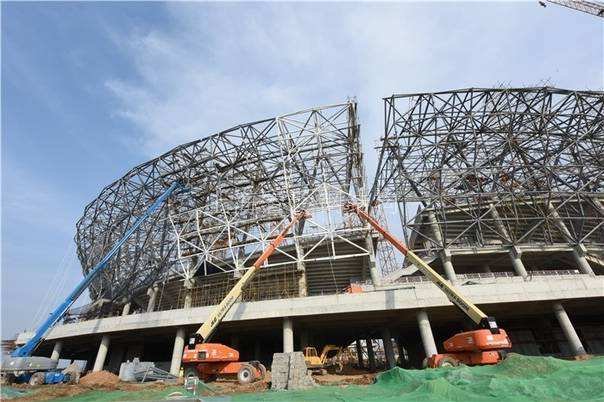Introduction to the Manufacturing Process of Steel Grid Structure
更新时间:2025-02-14 15:42:37•点击:147907 • Grid Knowledge

The production process of steel truss is a complex and delicate work, mainly including the following steps:
Raw material preparation
Material procurement: According to design requirements, purchase steel materials that meet specifications and quality standards, such as steel plates, steel pipes, etc., while ensuring the quality of auxiliary materials such as bolt balls, welding rods, and welding wires.
Quality inspection: Check the quality certification documents of steel, including material list, certificate of conformity, etc. Measure the external dimensions of the steel and check if it meets the standards. The surface of the steel is not allowed to have serious defects such as rust, pitting, and scratches.
Layout and cutting
Accurate layout: Construction personnel need to carefully check the construction drawings and layout or calculate the dimensions of important nodes. According to the design drawings, accurately draw the contour lines, groove shapes, and dimensions of the components on the template, and make the template and sample rod.
Reasonable cutting: According to the layout size, use appropriate cutting equipment for cutting. Steel pipe components are often cut using sawing machines or grinding wheel cutting machines to ensure the accuracy of length and groove; Steel plates can be cut using equipment such as shearing machines and flame cutting machines.
Rod production
Groove processing: When the wall thickness of the steel pipe exceeds 4mm, it needs to be processed into a groove to ensure welding quality. The angle and size of the groove should comply with the design and welding process requirements.
Welding treatment: When welding steel pipes with sealing plates and steel pipes, grooves must be made according to the requirements. During the welding process, it is necessary to control the welding current, voltage, and welding speed, adopt an appropriate welding sequence, and minimize welding deformation and stress as much as possible.
Quality inspection: After welding is completed, clean the slag and spatter on the surface of the weld seam, check the appearance quality of the weld seam, and ensure that there are no defects such as cracks, pores, slag inclusions, undercutting, etc. If necessary, perform non-destructive testing such as ultrasonic or radiographic testing.
Ball node production
Blank processing: Semi spherical balls with welded ball nodes are generally formed by hot pressing or casting steel plates. Bolt ball blanks are often formed by forging 45 # steel.
Machining processing: Machining the rough ball on the lathe, grinding the outer circle, milling the plane, tapping, etc., to ensure the diameter, roundness, and accuracy of the screw hole of the ball.
Quality inspection: Check the size deviation, surface quality, etc. of the ball joint to ensure that it meets the design and specification requirements.
Anti corrosion treatment
Surface rust removal: Sandblasting, shot blasting and other methods are used to remove rust from the surface of steel components, achieving a rust removal grade of Sa2.5 or higher, in order to enhance the adhesion of anti-corrosion coatings.
Painting construction: Select suitable anti-corrosion coatings for painting according to design requirements. Generally, the primer is applied first, followed by the intermediate and topcoat, to control the thickness and uniformity of the coating and ensure the anti-corrosion effect.
Number and packaging
Component number: Clearly mark the component number, specifications, installation location, and other information on the surface of the component using white paint or steel stamps, for easy identification and search during on-site installation.
Packaging and transportation: Small components can be packed or packaged, while large components can be transported directly. During transportation, protective measures should be taken to prevent deformation, damage, and coating detachment of components.
笔记
Recommended Reading
-
Full analysis of seismic design and maintenance of grid structure
2025-02-27 16:16:52•681715 次
-
What are the key process points to follow in order to ensure the quality of grid processing?
2025-02-27 11:21:00•107891 次
-
What type of construction is the grid mainly suitable for?
2025-02-25 16:42:00•104357 次
-
Quality control requirements of grid manufacturers!
2025-02-25 16:02:44•199949 次






